Client Spotlight: The Taylor’s!
Client Spotlight: Josh and Laura Taylor

There are two definitions of funky: 1) something that’s cool, and 2) something that smells bad. For our purposes, we’ll be talking about the latter—and the tragic consequences if this stench is emanating from your home.
The problem is, you may be so accustomed to your home’s smell that you don’t even notice when your guests are knocked off their feet when they enter your home. And whether you’re just entertaining or are hoping to sell your home, off-putting smells can be a huge turnoff, even if your home is immaculate otherwise. To help, here’s your ultimate guide to all the odors that can assail your home and how to get rid of them once and for all.
Cause: Your refrigerator and garbage disposal are basically burping up decaying food.
What to do: Purge your refrigerator on a regular basis, and clean the shelves and drawers to remove rotten spilled liquid. Yes, this is gross. Do it.
“Use distilled white vinegar or hydrogen peroxide and a microfiber cloth,” says cleaning expert Leslie Reichert. To rid your sink of stink, clear rotting food from the blades of your garbage disposal by putting ice cubes down it with some salt and frozen lemon peels.
Cause: The most common nose-crinkling smells in a home are caused by the furry friends that live with us, usually because they don’t always relieve themselves where they should. Odors can also be due to a lingering stench on animal fur, says Frank Lesh, executive director of the American Society of Home Inspectors.
What to do: If a cat or dog uses a carpet as a toilet, use a pet enzyme removal product such as Resolve on the offending area to remove all trace of the scent and find an effective way to deter your pet from a repeat performance in a spot it may consider its own.
For litter boxes, sprinkling a bit of baking soda can work wonders. If shedding is your nemesis, vacuuming the fur (off the floor and furniture) and spot-deodorizing should do the trick.
If all of the above do not work, removal of the offending furniture or rug is often the only way to resolve the issue, says Lesh.
Cause: Think of carpets as large sponges that absorb all the smells in your home—from pet odors to sweaty feet to pungent cooking, and beyond.
What to do: For large olfactory challenges, call in a steam cleaner. For smaller yet troublesome areas, put some cheap vodka in a spray bottle and lightly mist the carpeting.
“When the vodka evaporates, it will take the smells with it,” Reichert says.
Cause: Your air conditioner dehumidifies the air as it cools, but stagnant water can collect in an AC unit, allowing mold and mildew to grow in the lingering moisture. This can result in a smell similar to sweaty extremities wafting from air vents, says Richard Ciresi, a multiple-unit franchisee of Aire Serv in Louisville, KY. And, in addition, if someone in your home smokes, the fumes can get pulled into the condenser coil and recycled into your home every time you run the AC, says Ciresi.
What to do: A quick cleaning and repair to help excess water drain properly should remedy a mildew issue. Since a dirty filter can also harbor mold growth, replace filters regularly. To banish lingering smoke smells, clean the coil.
Cause: Water’s the culprit! “Basement smell” can severely affect the structural integrity of your home as well as your health. Although water can accumulate anywhere, areas where dampness tends to hide include the attic, basement, and bathrooms.
“If you have a water leak behind a wall or under a floor, wood rot may occur along with mold and mildew odors,” says Lesh.
What to do: Finding small leaks early can help prevent serious water damage and offending stenches.
“I recommend looking at the underside of the attic roof at least twice a year or after heavy rain/snowfall in the spring,” says Lesh. In a basement or crawl space, water accumulation is often caused by poor drainage from the roof. Keep your gutters clean and the downspouts flowing away from the foundation. And always dry out damp areas with a humidifier.
Cause: You may smell a truly weird odor the first time you fire up your furnace in the fall. But relax, it’s typically from the accumulated dirt that falls into the floor ducts, says Lesh. This scent may permeate the entire house for a while when the debris first heats up.
What to do: Simple—clean the ducts before you turn your heat on each year.
Cause: Stagnant air holds on to dust, dander, and dust mites.
“This usually happens in the summer and winter as we all keep our homes closed up because of air conditioning and heating,” says Reichert.
What to do: You can battle stale air just by opening a few windows once a week to increase air flow.
“Your home needs to have the air exchanged; and if you open some windows, you allow fresh air into the house and remove those stale odors,” says Reichert.
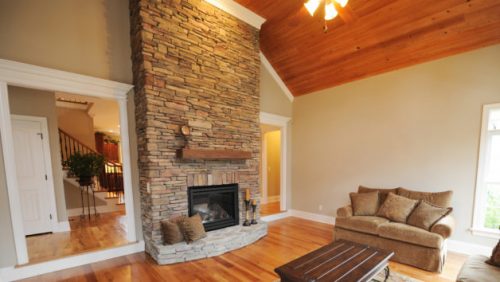
Whether or not there’s a crackling fire within, a fireplace is an eye-catching feature in a home—or at least, it can be. If yours appears a little drab and you’re pining for a new look, you’re in luck! A fireplace makeover is far easier (and cheaper) to pull off than you might think. To spark some ideas, here are five fireplace face-lifts that you can easily DIY in one weekend; they prove it really is possible to overhaul a brick behemoth without burning through your bank account.
Bored of brick? Glass tile can turn your fireplace into a true gem.
Erin Colburn of home design blog Magenta and Lime and her husband, Matt, pulled off this transformation themselves in just a few hours. Best of all, the total tab came to just $106 for tile, grout, and two-sided sticky paper on which to place the tiles (a true timesaver). Check out before-and-after pics below.
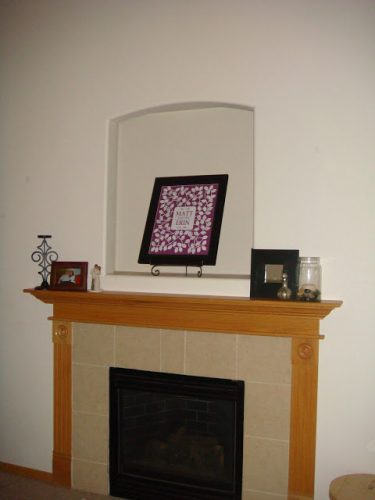
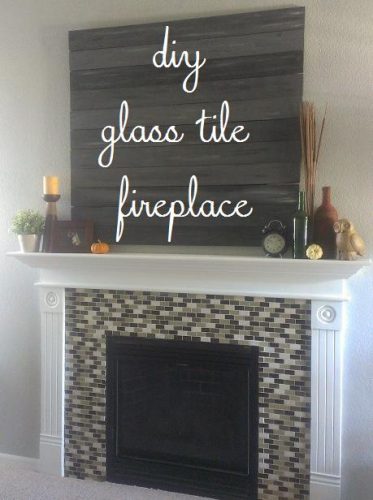
As Amy Boyle acknowledges, there are some people who view painting over brick as the ultimate sacrilege, but the 11 Magnolia Lane blogger wanted her fireplace to better reflect her style. So Boyle forged ahead and painted her basic builder bricks white—and then for a bit more interest, she added gray chalk paint. The subtle contrast really lends the fireplace more depth and character—all for the cost of a couple of cans of paint.
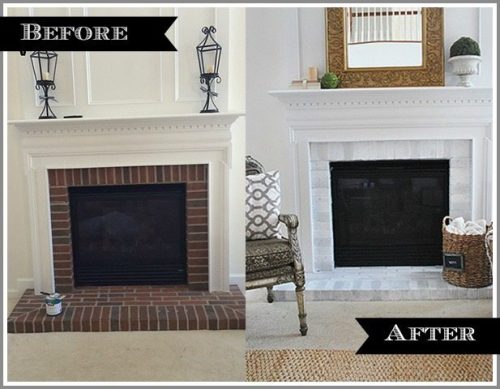
Chances are high you haven’t thought about the term “whitewashing” since reading “The Adventures of Tom Sawyer,” but applying that same technique to your fireplace stone will have you doing a double take in the best possible way.
Anneke McConnell outlines this easy face-lift on her blog, Coastal Collective Co. All it involves is chalk paint and sponges, to transfer the mixture to the stone without drips.
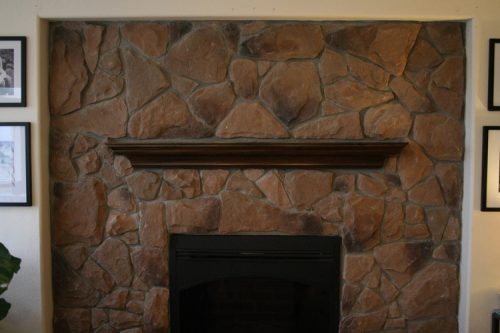
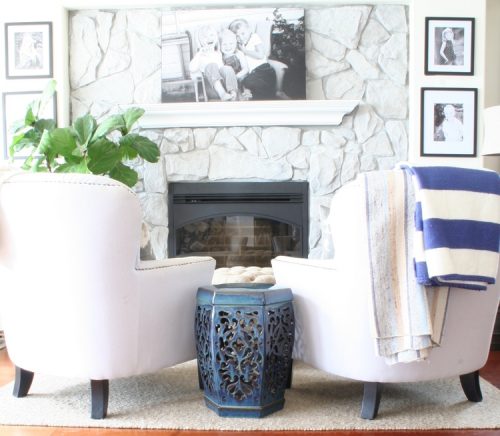
This fireplace went from meh to marvelous with the addition of floor-to-ceiling stone and—the clincher—a floating mantel. It really draws the eye upward and gives the whole room a lot more character. Lightweight faux stone is available at home improvement centers for a fraction of the cost of the real thing.
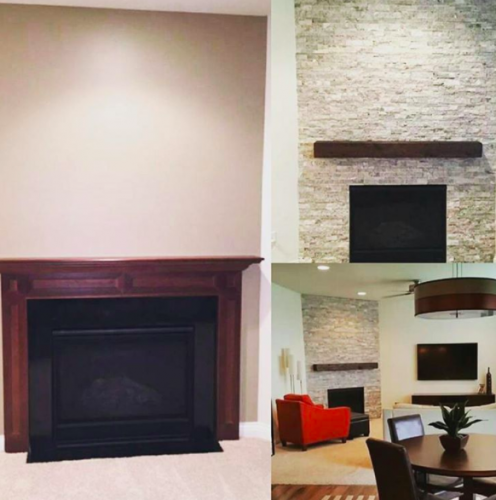
Cutting back the hearth and creating a uniform floor-to-ceiling stone facade really clean up the look of this fireplace. “Spacious,” “warm,” and “rustic” are adjectives that come to mind once this amenity was streamlined by the team at Urbane Design Studios.
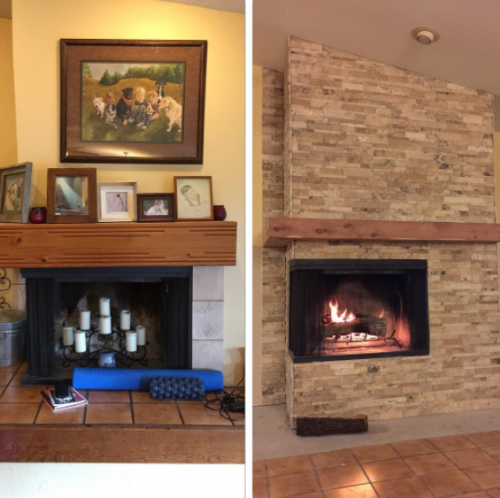
Interior renovation and design specialist Alice T. Chan says this fireplace makeover is among her all-time favorites.
“What’s with the two brick frames on top?” she asks. Who knows, but we’re sure glad they’re gone. These homeowners framed out a new facade to achieve a contemporary look and overlaid it with the dark gray porcelain tile. The solid walnut slab hearth and floating mantel complete the metamorphosis.
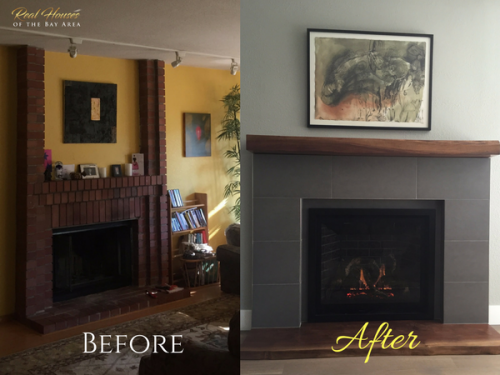
 Shalon is of the few people you’ll meet that was actually born and raised in North Carolina. She grew up in Roxboro and came to North Carolina State freshman year and has called Raleigh home ever since. There she met the love of her life, Tom. They have 2 boys, Thomas and Noah, who will be 9 and 5 this May. She’s the only girl in the house, even 3 male dogs that they’ve rescued- 1 St. Bernard and 2 poodle mixes. She lives in a boys house and she loves it! They love the Raleigh area because of all there is to do, especially as a homeschooler, they appreciate all the triangle has to offer. They also like to spend time in Lake Gaston with their family and friends.
Shalon is of the few people you’ll meet that was actually born and raised in North Carolina. She grew up in Roxboro and came to North Carolina State freshman year and has called Raleigh home ever since. There she met the love of her life, Tom. They have 2 boys, Thomas and Noah, who will be 9 and 5 this May. She’s the only girl in the house, even 3 male dogs that they’ve rescued- 1 St. Bernard and 2 poodle mixes. She lives in a boys house and she loves it! They love the Raleigh area because of all there is to do, especially as a homeschooler, they appreciate all the triangle has to offer. They also like to spend time in Lake Gaston with their family and friends.
 what, it is always a learning experience,” she said. Shalon said how she likes to see the look in clients eyes when they find “the one” but she does feel that home buying is very emotional. “Clients can have their spreadsheets and a house can check all the boxes but when you walk in if you don’t get that, ‘I can see myself living here’ feeling, then it’s not your home,” Shalon said. She works with her clients, both buyers and sellers, to find the house of their dreams or to help them transition out of one dream home into the next. “It’s always an adventure for sure, one with ups and downs but hopefully a happy ending,” she stated.
what, it is always a learning experience,” she said. Shalon said how she likes to see the look in clients eyes when they find “the one” but she does feel that home buying is very emotional. “Clients can have their spreadsheets and a house can check all the boxes but when you walk in if you don’t get that, ‘I can see myself living here’ feeling, then it’s not your home,” Shalon said. She works with her clients, both buyers and sellers, to find the house of their dreams or to help them transition out of one dream home into the next. “It’s always an adventure for sure, one with ups and downs but hopefully a happy ending,” she stated.
Buying and selling a home can be a juggling act: Drop a ball, and you may find yourself having to vacate your old home before the new one is ready for you to move in. From there, you have just a few choices: A) couch surf at friends’ and family’s homes until you wear out your welcome, B) pay through the nose for a hotel, or C) learn how to find temporary housing.
If you value your relationships, you will avoid option A. And unless you’re rolling in money, you’ll avoid B, too. Recent reports put the average hotel stay at $137 per night, which can add up fast if you’re stuck for weeks; plus, the novelty of room service can wear off when you just want a glass of milk out of the fridge.
So if you’re waiting weeks or months to move into a permanent home, you’ll want to consider some other options. Here’s an array of temporary housing arrangements, each with its own unique benefits and drawbacks depending on your needs and budget.
These are hotel rooms equipped with either full kitchens or kitchenettes and a desk and/or workspace. Many extended-stay hotels throw in free breakfast, happy hour, and front desk service, which can remove some of the stress of hotel living, especially if you have to feed and amuse a few kids while you’re waiting for your new home to be ready.
Generally the longer you stay, the cheaper the rates: 30 days will reduce the usual hotel rates by around 30%. Many regular hotels have extended-stay rooms, so be sure to inquire if a certain place is ideal for you.
These places are traditionally leased by companies for employees who need to stay awhile or are in the midst of finding a permanent residence. Still, don’t let the word “corporate” fool you.
Many corporate housing facilities are just as happy to accept any paying customer. You can find these apartments on special rental sites like BluCorporateHousing, and you’ll pay about half the price of a hotel room if you book for 28 days or longer. Many corporate housing apartments/homes are located in suburban areas, which can be nice for families.
The one thing they all have in common: They are “move-in ready,” says Mary Ann Passi, CEO of the Corporate Housing Providers Association, which is based in Indianapolis. “You bring your toothpaste and toothbrush, and you’re good to go.” (Bring some clothes, too.)
If you work for a company that is skilled in finding temporary housing for workers on the road, feel free to ask HR for suggestions. Your company may even be able to pass along discounts.
These are private houses rented with furnishings for long or short stays. If you’re bringing kids, this type of temporary housing can provide enough space for everyone. You can find these homes and apartments through sites like Airbnb and Homeaway. But don’t assume you’ll definitely pay a whole lot less.
According to one survey by Pricenomics, renting an apartment on Airbnb will cost you only about 21% less than renting a hotel (but keep in mind you get a whole lot more space for your money).
That said, local markets vary widely. According to a study by Busbud, in Toronto hotels cost twice as much as Airbnb. In Austin, TX, Airbnb costs twice as much as a hotel! So make sure to research your market to see which option is better. And if you’re staying for a while, ask for a discount—most will cut you a deal the longer you stay.
Before you start looking for temporary housing, think about who’s coming with you and what services you’ll need. If you’re bringing your family, you’ll need different accommodations than if you’re traveling solo.

The grass is getting greener, the days are getting longer, and the temperatures are making their slow march ever upward.
Spring is in the air—at least on the Northern Hemisphere.
And a smart home owner’s fancy turns to growth and efficiency of another sort—the lawn and garden.
The seasonal struggle to cultivate an enviable landscape and flower- or food-producing garden has taken new shape in this era of intelligent technology. While Saturdays of springs past were spent sweating on an unforgiving earth, we now have automated devices that’ll do the lion’s share of the work with greater results, and certainly less complaining.
Below, we show you how to get your hands dirty in the garden without actually getting your hands dirty in the garden.
We have previously sung the praises of the Rachio Smart Sprinkler Controller. This highly customizable sprinkler system, which constantly monitors the weather forecast and can automatically adjust watering schedules on the fly, remains a solid solution for luxury home owners looking to maintain a lush lawn.
Regardless of your lawn’s size or shape, Rachio ($199-$249) will work in conjunction with Mother Nature to keep your grass green.
However, homeowners who are also large garden owners might want to invest in Edyn.
The Edyn smart garden system consists of three elements. First, the Edyn Garden Sensor, a solar-powered probe which tracks the humidity, temperature, nutrition and moisture of your garden soil. The Sensor then cross-references that information with real-time weather information, plant databases, soil science and regional data to offer advice and gardening guidance, tailored to your exact garden, via the accompanying Edyn smart device app. In addition to providing tips for maintaining a flower bed of the first order, Edyn’s app will keep users apprised of their garden’s exact water needs and soil health, as well as any weather that could impact garden growth.
The final element of the Edyn system, the Edyn Water Valve, works off the actionable intelligence gathered by the Garden Sensor. Pairing with your existing irrigation system, the Edyn Water Valve will automatically control water flow to plants that need it based on the deep data gleaned from the soil sensor and real-time weather reports.
The end result is a garden with a lot more healthy flora and a lot less guesswork.
The Edyn Garden Sensor and Water Valve are available for $99 and $69, respectively. The Edyn Garden App can be downloaded for free.
In the long list of laborious lawn maintenance tasks, perhaps none is more arduous than the act of mowing.
The smell of fresh cut grass, while pleasant to some, can conjure memories in others of an adolescence spent behind a push mower at the prodding of parental forces in pursuit of such noble goals as character-building and a clean-looking landscape.
Now the scent of a freshly mowed lawn, and none of the psychological trauma, can be enjoyed by all thanks to the Husqvarna 450X Robot Automower.
Like a Roomba for the great outdoors, the Automower patrols your yard, based on guide-wire defined boundaries, shaving overgrown grass as it makes its rounds. The cutting machine is clever enough to navigate narrow passages and difficult terrain, as well as scale slopes of 45 degrees. Better still, the robot will recognize when it’s running out of battery and automatically return to its charging station.
With the Automower’s accompanying app, you can control the automaton from anywhere in the world, allowing you to return home from business or pleasure to the sights and smell of freshly groomed grounds.
The Husqvarna 450X Robot Automower is available for $3,499.
And how are you going to power the growing army of outdoor electronics? With the thematically and environmentally appropriate SmartFlower.
This plug-and-play solar power solution is all you could ask for in an energy provider—automated and intelligent.
After an installation process that takes about an hour, the SmartFlower will unfurl its flat petals and begin storing and supplying energy, automatically tracking the sun’s movement throughout the sky and allowing the unit to generate an optimal amount of solar power.
The weather-proof device constantly monitors wind speed and will automatically fold and conceal its petals should the gusts become a safety hazard. This retraction process has the added benefit of automatically cleaning the solar panels.
If you are interested in the The SmartFlower, you must first provide some information at SmartFlowerSolar.com to determine if the product is a good fit for your residence.
The joys of gardening are not restricted to homeowners in more rural or suburban environs.
The Wall Farm from Click & Grow brings fresh, healthy, pesticide-free fruits, herbs and greens into your urban dwelling—provided you have at least five feet to spare and a ceiling over six-and-a-half feet tall.
Resembling a bookshelf (but for buds), the Wall Farm comes equipped with full spectrum LED lighting that encourages growth from a diversity of plant life, and water tanks that are large enough to last for month-long intervals.
The vertical farming solution is seeded with “Smart Soil” capsules, provided by Click and Grow, that sprout up to 51 fruits and vegetables plants across 51 spots and three levels.
Low maintenance and silent, you wouldn’t even notice that you have a green grocer in your home if not for the verdant and abundant offerings.
The Wall Farm is available for $1,299. A monthly mini-subscription of $59 for 18 Smart Soil capsules is recommended.
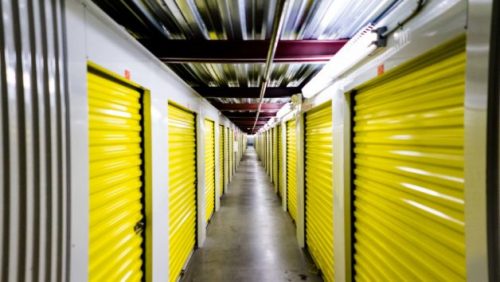
Sooner or later, life will call for you to store your stuff. Maybe you’re selling your home and need to declutter, or are in the dreaded “between places” mode, where you’re perched in a temporary crash pad until you can put down roots. Whatever the reason, you’ll be glad to know that your options for stashing your belongings are greater than you might have imagined.
Here are four types of storage to consider, and the pros, cons, and costs of each.
The most obvious option is self-storage—aka the storage unit. It’s a secure, flexible, and generally affordable choice. Self-storage is commonly used by clients when they’re packing up while the house is for sale, or if they are in between homes and staying at a hotel or with family, says Matt Casady, marketing manager for STOR-N-LOCK Self Storage in Salt Lake City.
Pros: Many self-storage facilities offer 24-hour access, seven days a week, which can be helpful when you’re finishing up your packing in the wee hours of the morning. In addition, says Casady, facilities typically have 24/7 video and alarm monitoring and gate access that only permits current customers to enter.
Cons: You have to be able to provide your own transportation to the storage unit.
Costs: Self-serve storage unit prices can vary greatly depending on which city you’re in, what features are offered (high-end storage units include a controlled climate or drive-up access), and of course, the size. A family looking to store the entire contents of a four-bedroom house will probably want a unit that’s 10-feet by 20-feet or larger, which typically runs between $150 to $230 a month, says Casady. One site that lets you compare sizes, amenities, and costs is Sparefoot.com.
Pros: Pods can be more convenient and less time-consuming than a storage unit, because you use the same container to store items and then move it to a new location (the pod company swings by to hitch it up to a truck). And since the pod is located on your property, you can pack it at your convenience.
Cons: Pods tend to be smaller than storage units, and can be seriously unsightly in your yard—a problem if you’re trying to sell your home.
Costs: The “original” PODS company has a quote finder on its site; for a 16-foot container, which is billed as storing the contents of three or four rooms, it’s about $175 a month, plus a $65 delivery and pickup charge (each way).
The name alone sounds fantastic, doesn’t it? This option is what’s known as “full-service” storage, which means that someone comes to pack and store your items; then will deliver them if, say, you have an unexpected need for your scuba gear or snowboard.
Pros: It doesn’t get any easier than this: The company will sweep in, and take a full inventory of items, says Nimrod Sheinberg, vice president of sales for Oz Moving & Storage in the greater New York area. You’ll get a list that includes a description of each item recorded by the number on the label, which means you can easily call to retrieve those golf clubs for a last-minute visit to the links.
“New Yorkers are typically busier and don’t have their own vehicles to haul items, so full-service storage providers are particularly appealing,” he says. Some companies will then provide moving services, which streamlines the process and saves both time and hassle.
Cons: You won’t have the flexibility to grab things out of your unit on a whim or at odd hours.
Costs: Costs vary, since the storage price is directly correlated with local real estate costs. This means that storage in New York is obviously much more expensive than it might be, for example, in Detroit. But according to the full-service storage company Clutter, its “apartment plan,” which covers a 9-foot by 27-foot space, costs $349 a month in Los Angeles.
In today’s peer-to-peer world, you knew someone would have had the ingenious idea of renting out their extraneous space—Airbnb for your stuff, so to speak. Here’s how it works: You go to a site like StoreAtMyHouse or Roost, and see if there’s anyone nearby with a basement, attic, or closet they are willing to “rent out.”
Pros: Renting someone’s extra space can be a very cost-effective solution, and since you’re dealing one-on-one, you can work out details with your host about your particular situation. “We have noticed that most hosts are very flexible in negotiating terms, once they find someone interested in renting their space,” says Fred Shaw, CEO of StoreAtMyHouse.
Cons: The cities where this service is available are still relatively limited. You’ll have to be flexible as to when you can retrieve your stuff.
Costs: The costs vary by area and are negotiable by host and guest, but Shaw says that he commonly sees spaces listed at around 50% less than the cost of commercial units for a comparable size and location.

“Should I buy a house?” This life-changing question is not something you casually ask the magic eight ball and get hit with a vague answer like, “Concentrate and ask again.” Instead of shaking a plastic novelty globe, there is an empirical way to find out if you should, in fact, buy a house or not—like asking yourself these questions below.
The first step is to find out whether you can buy a house given your current financial situation. Realtor.com’s home affordability calculator will help you figure out just how much house you can afford by plugging in your income, your monthly debts, how much of a down payment you can swing, and the type of mortgage you prefer. You’ll instantly get a figure telling you the top number you can pay for a property, plus what you’ll be looking at in monthly mortgage payments and insurance.
The whole “rent or buy?” question depends on which housing market you’re in, because inventory can make a huge difference. The good news is our Rent vs. Buy calculator can crunch the numbers for you. You’ll enter the current rent you’re paying (or could pay) and the ZIP code you want to live in. What you’ll get: a comparison of the cost of buying a home versus renting in that area. You’ll also see which one wins out over time (more on that next).
Generally the longer you live in a home, the smarter it is to buy rather than rent. Short-term stays? Renting might make more sense. The reason: When you buy a home, you’ll pay closing costs that can total thousands of dollars, plus most of your early mortgage payments go toward interest rather than whittling down the principal (the actual amount you owe on your home). As a result, as a rule of thumb, home buyers should plan to stay put at least five years. If you might move before that point, you should stick with renting instead.
We know, we know: Retirement seems a long ways off. Still, it’s crucial to start storing those nuts early. So if you’re neglecting your 401(k) to funnel all your funds toward a home purchase, that may not be the best allocation of resources (particularly if your employer matches funds, which is free money). Another reason: Setting aside money in a retirement account must be done the year you earn that income; you can’t go back later with a wad of cash and hope to squeeze it in.
Another reason to not ignore retirement accounts is that any money you put in an IRA can be withdrawn for a first-time home purchase, provided you meet certain requirements (like you withdraw less than $10,000 and the account has been open at least five years). Just know that 401(k)s are different, however (you’ll be penalized with a 10% excise tax on any cash you withdraw).
With rentals, you can just call your landlord to fix that leaky faucet. With a home you own, it’s all on you. So ask yourself if you’re willing to forgo weekend bar crawls with friends in lieu of mowing the lawn or patching the roof.
Wisconsin Realtor® Jill Frank of Coldwell Banker recommends asking yourself the following: “Do I have the time, resources, and desire to take on home maintenance and repairs as well as yard maintenance?”
All that said, there are low-maintenance homes you can own: Condos, for instance, require less upkeep because you pay for others to take care of these tasks. Still, by and large, homeownership comes with responsibilities, so you should be sure you’re ready to embrace these obligations with open arms.

Mel comes to Home Coach with a varied and deep understanding of Real Estate and homes. Mel is a native North Carolinian and studied architecture at North Carolina State University and became a licensed architect in 1993. He has lead the renovations of many homes in the Raleigh area and has a unique understanding of how a home “lives and breathes”. During the last couple of years of residential sales, Mel has become a licensed NC home inspector, adding yet another dimension to his understanding of how homes mature.

Mel has been married to his wife Karyn for 28 years. He has two sons, Dalton 24 and Foster 19. The family can often be found at some type of NC State Wolfpack athletic event, or enjoying North Carolina’s hidden treasures usually by camping or hiking.

If you’re a newbie home buyer, you may be confused by what you need to do to snag a mortgage. We’re here to help! So let’s start with the basics: What exactly is a mortgage?
Since you probably don’t have hundreds of thousands of dollars lying around, a mortgage is a loan that enables you to cover the cost of a home. You pay back the loan over the course of years or even decades. Consider it the biggest, longest, most life-changing IOU you’ll ever give out!
But there’s a surprising variety of choices available. Here’s an introduction to everything you need to know about mortgages.
Believe it or not, you should shop around for a mortgage even before you start hunting for a house. It might not be as fun as checking out open houses, but it’s way more important.
You’re looking to get a mortgage “pre-approval,” which serves two main purposes: One, it will show the sellers that you are serious about buying a home, which is particularly crucial in a hot housing market, says Chantay Bridges with TruLine Realty in Los Angeles.
But more importantly, it will let you know how much home you can afford. Before you start browsing online listings or visiting open houses, take a look at our home affordability calculator, which will give you an idea of how big your mortgage will be.
Here are the main places you can get a mortgage:
When you apply for a mortgage, here are the main terms you’ll need to know:
Down payment: This is the money you must put down on a house to show a lender you have some skin in the game. Typically lenders like to see home buyers make a down payment totaling 20% of the price of the home (e.g., $40,000 on a $200,000 home), although in some cases they’ll take less.
Principal: This is the amount of money that you are borrowing and must pay back, which is the price of the home minus your down payment (taking the above example, you’d subtract $40,000 from $200,000 to get a principal of $160,000).
Interest: Lenders don’t just loan you the money because they’re good guys. They stand to make money off you, too, since you pay them back plus interest—a percentage of the money you borrow.
There are two main types of loans:
Loans also have different “terms,” which means how long you’ll make monthly payments. The two most common terms are 30 years and 15 years. The payment on a 15-year loan will obviously be higher each month you have it, but it will ultimately save you money in interest over the life of the loan.
Since loans come in all shapes, sizes, and interest rates, you should definitely shop around, much like you’d compare different laptops before settling on the best one for you. And, since interest rates fluctuate daily—which will have a direct impact on what you ultimately pay—you’ll want to do all your research during the same time period as much as possible, says Brandon Haefele, president and CEO of Sacramento-based Catalyst Mortgage and a member of the board of directors of the California Mortgage Bankers Association. That way, you know you’re making a valid comparison.
Working with a qualified (and patient) loan adviser can help you sort out your options. They can help you determine which type of loan is best for your situation and walk you through what your payments would be for different types and terms of loans. They’ll also break down the various fees that come with each loan.
By understanding what a mortgage is and all the different types available, you can make the choice that’s right for you and your budget.
8480 Honeycutt Road, Suite
200, Raleigh, NC 27615
Phone: 919-714-7427
Email: info@HomeCoachNC.com


